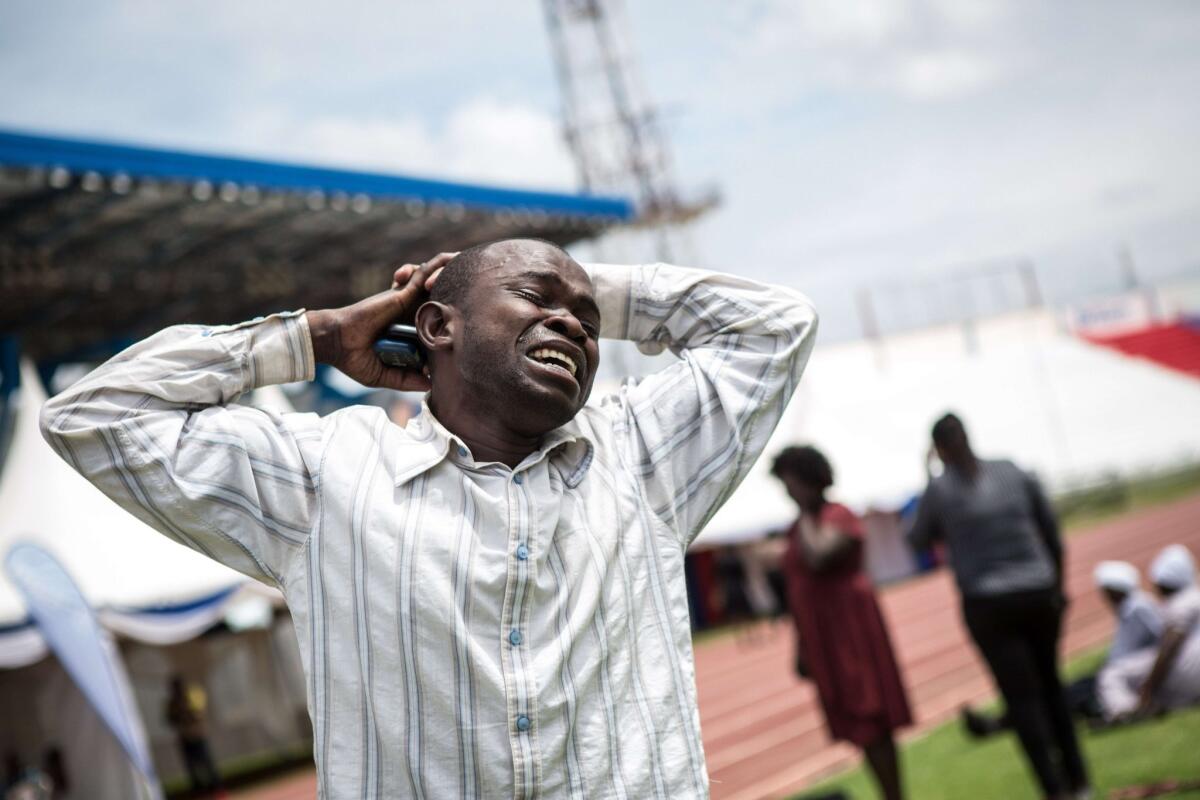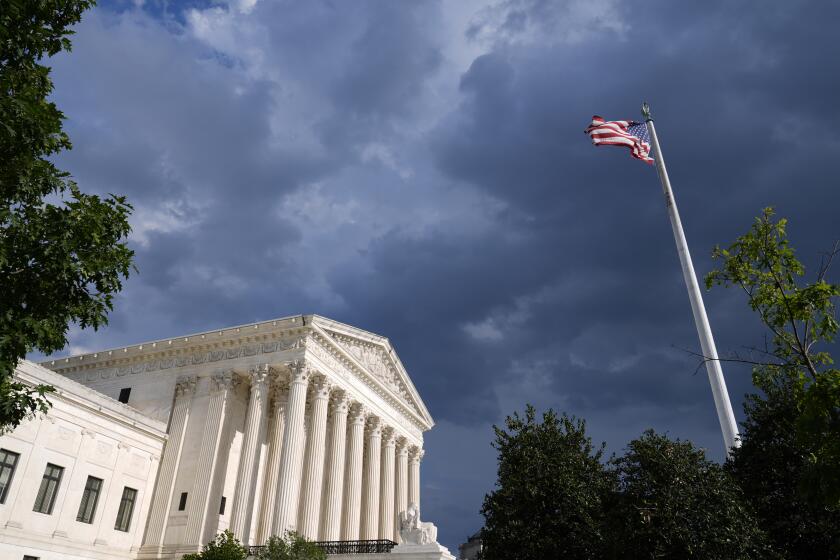At Kenya college, Christian students foretold massacre

- Share via
Reporting from Kitengela, Kenya — When the Somali militant group Shabab attacked Garissa University College, Stanley Muli, 22, hid in a wardrobe, wondering why the army stationed nearby was taking so long to arrive.
For two hours after the attack at 5:30 a.m. Thursday, no one came to the rescue as Muli listened as Shabab fighters searched rooms and killed terrified students. He thought bitterly about the students’ protest last November over the lack of university security, when the army had arrived swiftly and had beaten many students.
“I was just praying [to] God that the [Kenya Defense Forces] would come,” he said Sunday. “I was just thinking how come they have taken so long, because the barracks are near.”
In a town long known for violent extremist attacks, the campus of mainly Christian students was an obvious target in a predominantly Muslim area within striking distance of Somalia, 90 miles away. Students said they felt unsafe and exposed, knowing the university was vulnerable to attack.
“We were fearing that if these people [Shabab] came, they could kill many, many Christians,” said Muli, who had been shot in the thigh but survived in his hiding place. He said the government “failed to protect us. We are angry, because we lost some of our best friends. We think, ‘How come security wasn’t there when we were are the university?’ They took no care.”
Garissa University College was inaugurated in 2011, the first university in northeastern Kenya, but its first full-year intake was in 2013. Students said almost no one wanted to be there because of Garissa’s security problem, but they were declined spots on the mother campus, Moi University in Eldoret. Most wanted to transfer, but found it impossible.
“It’s like we were being experimented on. When this university was being put in that place, I don’t think it was the right place,” said Gideon Nyabwengi, 19, who escaped death by crouching behind the low, half-built wall of a washroom.
“When we went to that university, we thought what kind of university is this? The lack of security was a major thing. When you got your letter of admission to Garissa some people were saying it wasn’t safe to go. This thing was being predicted,” he said. Some of his friends told him he should get a gun if he was going to study at Garissa. Others said they would pray for him.
When the attack arrived, it was pitiless.
Hiding, Nyabwengi heard his best friend beg for his life, pretending to be a Muslim. When the friend was unable to recite a Muslim prayer, he was fatally shot, Nyabwengi said.
“I heard them shouting, ‘We’ve come to kill and be killed.’ They would go and bring some students out of the dormitories and shoot them. [The students] were told to lie down, then I’d hear gunshots, gunshots and crying.” In the three hours before he escaped, Shabab continued killing unimpeded.
Students said Kenya’s army eventually surrounded the campus but didn’t overcome Shabab or bring an end to the killings. A crack police squad, the General Service Unit, didn’t arrive until about 4:30 p.m., 11 hours after the attack, according to Kenyan media reports. The police ended the siege 30 minutes later.
Furious students and their parents question why the Garissa campus was left so poorly guarded, especially after recent, widely circulated intelligence warnings of an impending attack on a university. Students from a neighboring teachers college in Garissa were sent home Tuesday, two days before the attack, because of the uncertain security situation.
In January 2013 and again last September, Garissa residents protested over insecurity for non-indigenous residents in the town, after many killings, including shootings of hotel patrons.
In November, students angry at the lack of security at Garissa University College held a strike and demonstration. They demanded extra police guards and a fence. There were requests the campus be relocated.
Although the fence was built, survivors of Thursday’s attack said authorities failed to take the university’s security problem seriously enough.
Ironically, the high metal fence made it harder for some to escape. When Nyabwengi tried to vault the fence, he fell back down at the first attempt and was shot in the arm. On the second effort, he managed to get away. But he said that women students had a harder time scaling the fence.
Nyabwengi said he and many of his friends tried unsuccessfully to get a transfer.
“You had to struggle, use a lot of money for a bribe, or you were just wasting your time.”
Instead, students were told at orientation that security came down to the individual, with warnings that girls should avoid wearing miniskirts.
Nyabwengi said locals on occasion threw stones at female students in the town, apparently because they didn’t like the way they were dressed. Muli said that at his orientation last year, students were warned that local people had tried to strip a female student for wearing a miniskirt.
When Shabab claimed responsibility Thursday for the attack, it said the university was on Muslim land and was there to promote “missionary activities and to spread deviant ideology.”
Students said very few of the students on the campus were Muslims and even fewer were members of the local population. There had been local protests that few Garissa people had gotten jobs on the campus.
There was also tension over the presence of a mosque on the campus, used by the local community to pray. Students protested that those using the mosque weren’t subject to security checks. Seeing it as an added source of insecurity, they called for it to be moved off campus.
When the gunmen arrived, their first target was an early morning Christian prayer meeting. Of 29 students there, just seven survived.
“We were praying,” said Duncan Obwamu, 25. “We were in a circle in the room holding hands.” First, the barrel of a gun appeared at the door. Then it fired, striking a young woman leading prayers. A Shabab gunman stepped into the room and continued firing.
“He didn’t say anything, but you could see from the look on his face he was very happy,” he said. Obwamu, hit in the arm and shoulder, covered in the blood of other students, lay still as the gunman kicked the bodies to be sure they were dead. “I heard him laugh as he communicated with the others outside. He was very happy about what he’d done.”
Muli’s father, Joseph Mwavu, 50, a mason, said he was unhappy when his son got an admission letter to Garissa University College, “because the whole world knows that anywhere near the Somali border is dangerous.”
He said if help had arrived earlier on the day of the attack, many students could have been saved.
“I’m very bitter because [the government] had all the information. They knew what was happening but they took so many hours to respond,” said Mwavu.
Follow @RobynDixon_LAT for news from Africa
More to Read
Sign up for Essential California
The most important California stories and recommendations in your inbox every morning.
You may occasionally receive promotional content from the Los Angeles Times.













